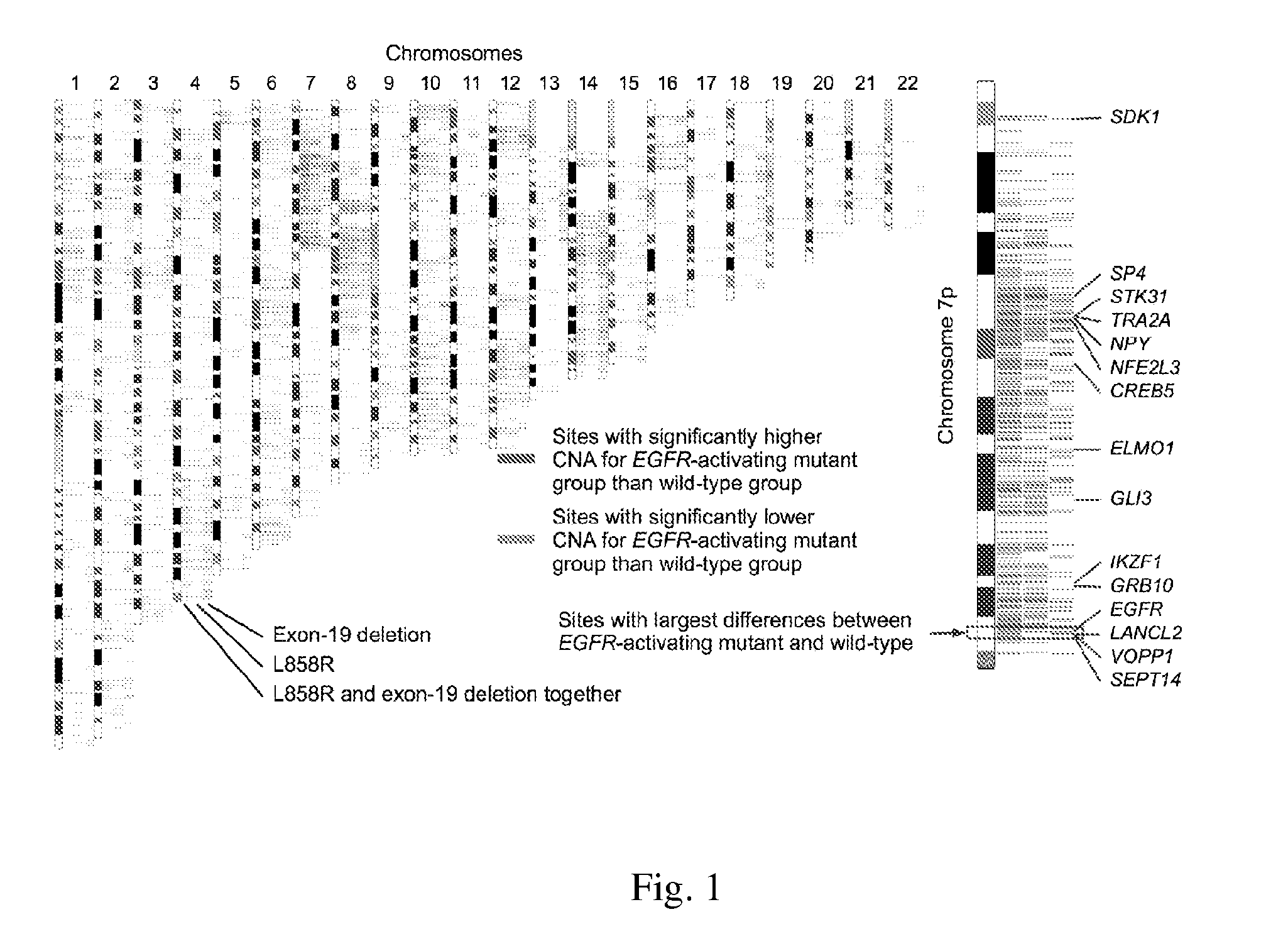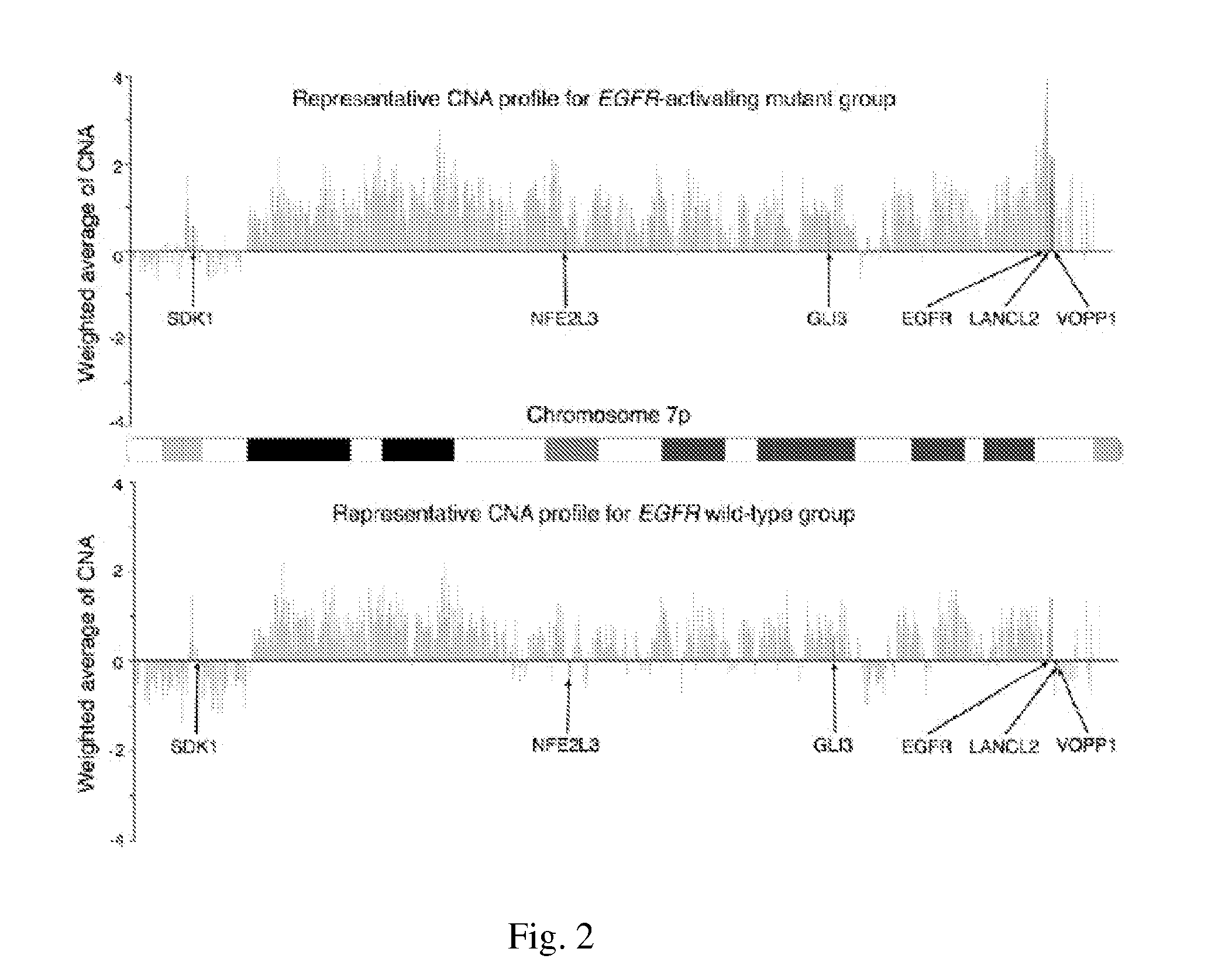Method for predicting response or prognosis of lung adenocarcinoma with egfr-activating mutations
a technology of egfr and egfractivating mutations, applied in the field of predicting the response or the prognosis of lung adenocarcinoma with egfr-activating mutations, can solve the problems of poor treatment of lung adenocarcinoma (such as non-small-cell lung cancer), not always possible depending, and the effect is not satisfactory
- Summary
- Abstract
- Description
- Claims
- Application Information
AI Technical Summary
Benefits of technology
Problems solved by technology
Method used
Image
Examples
example 1
CNA Profiling Results
[0051]CNA profiling on 138 tumors of lung adenocarcinoma was conducted by the array CGH of NimbleGen system. The resulting CNA profiles were shown in FIG. 1A. The statistical analysis detected a total of 3,187 probe-blocks of DNA-gain and 6,029 probe-blocks of DNA-loss with false discovery rates of 0.054 and 0.028 respectively.
example 2
Chromosome 7p has Highest Rate of DNA-Gain for the Gene-Harboring Regions
[0052]The chromosome sites with DNA gains were examined first. It was found that relative to the arm size, chromosome 5p, 7p, and 8q had the largest region of DNA-gain (Table 2). For the gene-harboring region, the gain rate for chromosome 7p turned out the highest. Significantly, EGFR was in the list, along with other notable genes like HDAC9, DGKB, MEOX2 and POU6F2, all of which were within the top 1% genome-wide when ranking the probe-blocks according to their average CNA values across all 138 samples (Table 3).
TABLE 2Chromosome wide DNA gain / loss percentagesNumber ofNumber ofNumber ofNumber ofgene-haboringNumber ofgene-haboringprobe-gain probe-gain probe-loss probe-loss probe-Chromosomeblocksblocks (%)blocks (%)blocks (%)blocks (%) 1p1624144 (8.9%) 59 (3.6%) 316 (19.5%) 269 (16.6%) 1q1398 213 (15.2%)100 (7.2%) 103 (7.4%) 89 (6.4%) 2p1252100 (8%) 26 (2.1%) 148 (11.8%)107 (8.5%) 2q2038 241 (10.5%)111 (5.4%...
example 3
Chromosome 7p Contains the Highest Proportion of the Most Notable Amplification for the EGFR-Mutation Group
[0054]EGFR-mutation testing for the presence of the exon-21 L858R point mutation or the exon-19 in-frame deletion was conducted. It was found a total of 81 patients had EGFR mutation of either type and 57 patients were the wild-type. The sites with most notable amplification or deletion in the EGFR-mutant patients was studied and regions with highest DNA gain and loss was located by identifying the top 1% of probe-blocks with the largest and the smallest mean values of CNA respectively. Interestingly, 81 out of 364 (22.3%) probe-blocks with highest CNA fall on chromosome 7p, outnumbering all other chromosome arms despite the smallness in the arm size (carrying only 2.25% of probe blocks in the array). The same pattern still occurred for the two EGFR mutation types studied separately. On the other hand, for the EGFR wild-type group, the pattern was completely different and chrom...
PUM
| Property | Measurement | Unit |
|---|---|---|
| threshold | aaaaa | aaaaa |
| threshold | aaaaa | aaaaa |
| heterogeneity | aaaaa | aaaaa |
Abstract
Description
Claims
Application Information
 Login to View More
Login to View More - R&D
- Intellectual Property
- Life Sciences
- Materials
- Tech Scout
- Unparalleled Data Quality
- Higher Quality Content
- 60% Fewer Hallucinations
Browse by: Latest US Patents, China's latest patents, Technical Efficacy Thesaurus, Application Domain, Technology Topic, Popular Technical Reports.
© 2025 PatSnap. All rights reserved.Legal|Privacy policy|Modern Slavery Act Transparency Statement|Sitemap|About US| Contact US: help@patsnap.com



